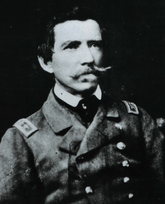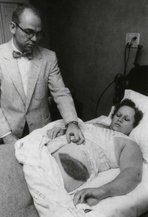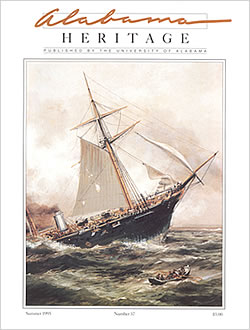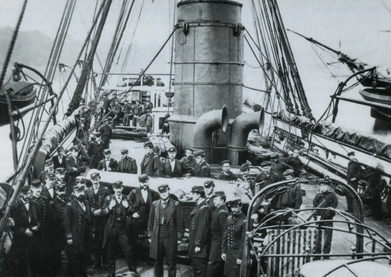|
On the cover: Detail from Xanthus Smith's 1876 painting of the historic sea battle between CSS Alabama and USS Kearsarge. (Courtesy AmSouth Bank, Mobile)
|
FEATURE ABSTRACTS
 Captain Raphael Semmes captured nearly seventy vessels as captain of the CSS Alabama. (Courtesy William Stanley Hoole Special Collections Library, University of Alabama)
Captain Raphael Semmes captured nearly seventy vessels as captain of the CSS Alabama. (Courtesy William Stanley Hoole Special Collections Library, University of Alabama)
The Saga of CSS Alabama
By Christopher M. Henze
This issue chronicles the adventures of the CSS Alabama, the Confederacy's deadliest raider, including the discovery of her wreck off the coast of France and recent salvage efforts. Though the Alabama never once berthed in a Confederate port, her exploits boosted the morale of Southerners as she made an epic--and deadly--maritime journey around the world. During the Alabama's 22-month campaign, her commander, Captain Raphael Semmes of Mobile and his crew captured or sank 65 Union merchant vessels at a cost of approximately $6 million to the Union. Author Christopher Henze, a U. S. diplomat for 25 years, served as a cultural attache at the American embassy in Paris and acted as liaison between the French and the American sides in negotiations over ownership of the Alabama artifacts.
Additional Information
About the Author
A United States diplomat for twenty-five years, Christopher Henze first developed an interest in CSS Alabama while serving at the U.S. Mission to the United Nations in Geneva. Later, as cultural attache at the American embassy in Paris, he acted as liaison between the French and American sides in negotiations over ownership of the Alabama artifacts. Henze retired from the Foreign Service in 1992 and is currently a consultant at the International Energy Agency in Paris.
The author wishes to thank Brian Turner of the U.S. Mission in Geneva and Ulane Bonnel, president of the Association CSS Alabama, for their support. Dr. Bonnel, a maritime historian, is spearheading efforts to explore the CSS Alabama.
For more information, contact:
Association CSS Alabama
Fondation Mona Bismarck
24 avenue de New York
75116 Paris
France
By Christopher M. Henze
This issue chronicles the adventures of the CSS Alabama, the Confederacy's deadliest raider, including the discovery of her wreck off the coast of France and recent salvage efforts. Though the Alabama never once berthed in a Confederate port, her exploits boosted the morale of Southerners as she made an epic--and deadly--maritime journey around the world. During the Alabama's 22-month campaign, her commander, Captain Raphael Semmes of Mobile and his crew captured or sank 65 Union merchant vessels at a cost of approximately $6 million to the Union. Author Christopher Henze, a U. S. diplomat for 25 years, served as a cultural attache at the American embassy in Paris and acted as liaison between the French and the American sides in negotiations over ownership of the Alabama artifacts.
Additional Information
- Bonnel, Ulane. "Alabama Update," The French American Review (Winter 1991): 53-54.
- Hyde, Delia and Ulane Bonnel. "The Alabama Challenge: The Confederate Raider Will Rise Again," Laurels (Spring 1990): 7-22.
- Jones, Virgil Carrington. The Civil War at Sea (Holt, Rinehart, Winston, 1962).
- Meriwether, Colyer. Raphael Semmes (George W. Jacobs & Company, 1913).
- Mysyrovicz, Ladislas. The Alabama Arbitration, Geneva 1872, translated by Frederick B. Turner, Geneva, 1988.
- Porter, David D. The Naval History of the Civil War (The Sherman Publishing Company, 1886).
- Semmes, Raphael. My Adventures Afloat (Richard Bartley, New Burlington Street, 1869).
- Sinclair, Arthur. Two Years on the Alabama (Lee and Shepard Publishers, 1895); republished by the University of Alabama Press.
- Soley, James Russell. The Navy in the Civil War (Charles Scribner's Sons, 1903).
- Summersell, Charles Grayson. CSS Alabama: Builder, Captain, and Plans (The University of Alabama Press, 1985).
- CSS Alabama Cannon
- CSS Alabama Fire Hose
- CSS Alabama Sinking the USS Hatteras
- CSS Alabama
- Raphael Semmes on the CSS Alabama
- Raphael Semmes
About the Author
A United States diplomat for twenty-five years, Christopher Henze first developed an interest in CSS Alabama while serving at the U.S. Mission to the United Nations in Geneva. Later, as cultural attache at the American embassy in Paris, he acted as liaison between the French and American sides in negotiations over ownership of the Alabama artifacts. Henze retired from the Foreign Service in 1992 and is currently a consultant at the International Energy Agency in Paris.
The author wishes to thank Brian Turner of the U.S. Mission in Geneva and Ulane Bonnel, president of the Association CSS Alabama, for their support. Dr. Bonnel, a maritime historian, is spearheading efforts to explore the CSS Alabama.
For more information, contact:
Association CSS Alabama
Fondation Mona Bismarck
24 avenue de New York
75116 Paris
France
USS Kearsarge: The Last of a Legend
By Eugene Alvarez
A companion piece, this article recounts a little-known story of the final days of USS Kearsarge, which ran aground in the Caribbean in 1894. Her captain and navigator were brought up on charges of "inefficiency in the performance of duty" and "negligence." Both were found guilty.
Additional Information
About the Author
Eugene Alvarez received his Ph.D. in history from the University of Georgia. Professor Alvarez, recently retired from Macon College, University of Georgia System, has published numerous magazine and journal articles and is the author of Travel on Southern Antebellum Railroads, 1828-1860 (University of Alabama Press, 1974) and Where It All Begins: A History of the United States Marine Corps Recruit Depot, Parris Island, South Carolina.
The author wishes to thank Col. Andrew I. Lyman, USMC (Ret.), for his assistance with this article and for information concerning the USS Kearsarge and his grandfather, Lt. Charles H. Lyman, USN. Additional records were furnished by William W Jeffries, United States Naval Academy Archivist and Museum Director, and Mr. Stanley Kalkus, Director, Navy Department Library, Washington Navy Yard, Washington, D.C. The author would also like to thank Dr. Stephen Wise for reading and commenting on the text.
By Eugene Alvarez
A companion piece, this article recounts a little-known story of the final days of USS Kearsarge, which ran aground in the Caribbean in 1894. Her captain and navigator were brought up on charges of "inefficiency in the performance of duty" and "negligence." Both were found guilty.
Additional Information
- "Annual Report of the Secretary of the Navy for the Year 1894," (Government Printing Office, 1894)
- "Report of the Proceedings of a General Court Martial Convened at the Navy Yard, New York, March 22, 1894. Trial of Commander Oscar E Heyerman," (Military Section, National Archives, Washington, D.C.);
- Dean, Paul. "Treasure Hunter Uncovers Mate of Monitor, Merrimack," Norfolk, Virginia, Virginian-Pilot: March 14, 1987.
- Finegan, Jay. "Name That Ship," the Times Magazine (a supplement to Navy Times of the same date), January 9, 1984
- Leatherneck, December 1993
- Marine Corps Gazette, June 1992
About the Author
Eugene Alvarez received his Ph.D. in history from the University of Georgia. Professor Alvarez, recently retired from Macon College, University of Georgia System, has published numerous magazine and journal articles and is the author of Travel on Southern Antebellum Railroads, 1828-1860 (University of Alabama Press, 1974) and Where It All Begins: A History of the United States Marine Corps Recruit Depot, Parris Island, South Carolina.
The author wishes to thank Col. Andrew I. Lyman, USMC (Ret.), for his assistance with this article and for information concerning the USS Kearsarge and his grandfather, Lt. Charles H. Lyman, USN. Additional records were furnished by William W Jeffries, United States Naval Academy Archivist and Museum Director, and Mr. Stanley Kalkus, Director, Navy Department Library, Washington Navy Yard, Washington, D.C. The author would also like to thank Dr. Stephen Wise for reading and commenting on the text.
 Life magazine photographer Jay Leviton snapped this now-famous picture of Mrs. Hodges in the Sylacauga hospital, when Dr. Moody Jacobs pulled the covers back to reveal her bruised hip. (Courtesy Jay Leviton, Atlanta)
Life magazine photographer Jay Leviton snapped this now-famous picture of Mrs. Hodges in the Sylacauga hospital, when Dr. Moody Jacobs pulled the covers back to reveal her bruised hip. (Courtesy Jay Leviton, Atlanta)
Ann Hodges and the Hand of Fate
By John C. Hall and Harold Povenmire
Ann Hodges of Sylacauga is the only documented case of a person being injured by a meteorite. Her remarkable story attracted national media attention. In Alabama, the publicity focused on a law suit brought by Hodges' landlady, who claimed that she was the rightful owner of the meteorite. The public sided with Mrs. Hodges, who told the pres, "I think God intended it for me. After all, it hit me!" Although the landlady won the lawsuit, Hodges, after a modest private settlement, was able to reclaim the meteorite, which she later donated to the Alabama Museum of Natural History at the University of Alabama. The 8 1/2 pound meteorite remains there today on display. Another 3-3/4 pound fragment of the same meteorite found by a farmer nearby is on display at the Hall of Meteorites at the National Museum of Natural History in Washington, D.C.
Additional Information
The following article in the Encyclopedia of Alabama will also be of interest:Multimedia:
About the Author
John Hall is Director of Interpretation of the University of Alabama Museums. The fall of the Hodges meteorite is a clear memory of his childhood. His father, Cody Hall, then a reporter for the Anniston Star, was one of the many newsmen who covered the story. "I went down to Sylacauga thinking I was covering a plane wreck," Cody Hall recalls. "It was just like a circus by the time I got there." The Hodges meteorite story "has kind of followed me around," says John Hall. Not only did his father cover the Sylacauga story, his parents met in a Smith Hall geology class in 1941, about fifty feet from where the meteorite is now displayed and the same distance from Hall's present office.
Meteor expert Harold Povenmire has spent a lifetime fascinated by astronomy, particularly meteorites. He has held a number of posts with NASA and has been director of several planetariums in the Cape Canaveral area. In recent years he has taught astronomy and followed his meteor interests, resulting in the publication of several books, including Fireballs, Meteors and Meteorites. Povenmire has been following the Hodges meteorite story for more than ten years and has. interviewed most of the surviving participants. Despite an extended effort, he has been unable to verify the existence of a reported third fragment. Povenmire serves as an advisor to the Alabama Museum of Natural History in meteorics.
By John C. Hall and Harold Povenmire
Ann Hodges of Sylacauga is the only documented case of a person being injured by a meteorite. Her remarkable story attracted national media attention. In Alabama, the publicity focused on a law suit brought by Hodges' landlady, who claimed that she was the rightful owner of the meteorite. The public sided with Mrs. Hodges, who told the pres, "I think God intended it for me. After all, it hit me!" Although the landlady won the lawsuit, Hodges, after a modest private settlement, was able to reclaim the meteorite, which she later donated to the Alabama Museum of Natural History at the University of Alabama. The 8 1/2 pound meteorite remains there today on display. Another 3-3/4 pound fragment of the same meteorite found by a farmer nearby is on display at the Hall of Meteorites at the National Museum of Natural History in Washington, D.C.
Additional Information
The following article in the Encyclopedia of Alabama will also be of interest:Multimedia:
About the Author
John Hall is Director of Interpretation of the University of Alabama Museums. The fall of the Hodges meteorite is a clear memory of his childhood. His father, Cody Hall, then a reporter for the Anniston Star, was one of the many newsmen who covered the story. "I went down to Sylacauga thinking I was covering a plane wreck," Cody Hall recalls. "It was just like a circus by the time I got there." The Hodges meteorite story "has kind of followed me around," says John Hall. Not only did his father cover the Sylacauga story, his parents met in a Smith Hall geology class in 1941, about fifty feet from where the meteorite is now displayed and the same distance from Hall's present office.
Meteor expert Harold Povenmire has spent a lifetime fascinated by astronomy, particularly meteorites. He has held a number of posts with NASA and has been director of several planetariums in the Cape Canaveral area. In recent years he has taught astronomy and followed his meteor interests, resulting in the publication of several books, including Fireballs, Meteors and Meteorites. Povenmire has been following the Hodges meteorite story for more than ten years and has. interviewed most of the surviving participants. Despite an extended effort, he has been unable to verify the existence of a reported third fragment. Povenmire serves as an advisor to the Alabama Museum of Natural History in meteorics.
DEPARTMENT ABSTRACTS
From the Archives
"The Gold Star Book-Personal Memories of Alabamians Who Died in the Great War"
By Joan S. Clemens
In 1920 Marie Bankhead Owen, succeeded her late husband, Thomas M. Owen, as director of the Alabama Department of Archives and History. Part of her purpose was to complete her husband's dream of creating a Gold Star book in honor of American soldiers killed during the Great War. However, she was never able to complete the project; after World War I, Americans turned their attention inward and did not want to be reminded of the European conflict. Neither did the Alabama legislature, which did not provide the necessary funding to support the project. The results of Mrs. Owen's extensive research, however, are with us still, buried in the midst of a records series at the Alabama Department of Archives and History called the Public Information Subject Files--Alabamians at War.
About the Author
Joan Clemens is a state government records archivist at the Alabama Department of Archives and History, Montgomery.
"The Gold Star Book-Personal Memories of Alabamians Who Died in the Great War"
By Joan S. Clemens
In 1920 Marie Bankhead Owen, succeeded her late husband, Thomas M. Owen, as director of the Alabama Department of Archives and History. Part of her purpose was to complete her husband's dream of creating a Gold Star book in honor of American soldiers killed during the Great War. However, she was never able to complete the project; after World War I, Americans turned their attention inward and did not want to be reminded of the European conflict. Neither did the Alabama legislature, which did not provide the necessary funding to support the project. The results of Mrs. Owen's extensive research, however, are with us still, buried in the midst of a records series at the Alabama Department of Archives and History called the Public Information Subject Files--Alabamians at War.
About the Author
Joan Clemens is a state government records archivist at the Alabama Department of Archives and History, Montgomery.
The Nature Journal
Jack (or Jill)-In-The-Pulpit
By L. J. Davenport
The common Alabama woodland plant jack-in-the-pulpit follows a complex sexual scenario known as sequential hermaphroditism in which an individual plant will "choose" to be either male or female depending on its reproductive potential. L.J. Davenport examines this complex reproductive cycle.
About the Author
L. J. Davenport is professor of biology at Samford University in Birmingham, Alabama.
Jack (or Jill)-In-The-Pulpit
By L. J. Davenport
The common Alabama woodland plant jack-in-the-pulpit follows a complex sexual scenario known as sequential hermaphroditism in which an individual plant will "choose" to be either male or female depending on its reproductive potential. L.J. Davenport examines this complex reproductive cycle.
About the Author
L. J. Davenport is professor of biology at Samford University in Birmingham, Alabama.

